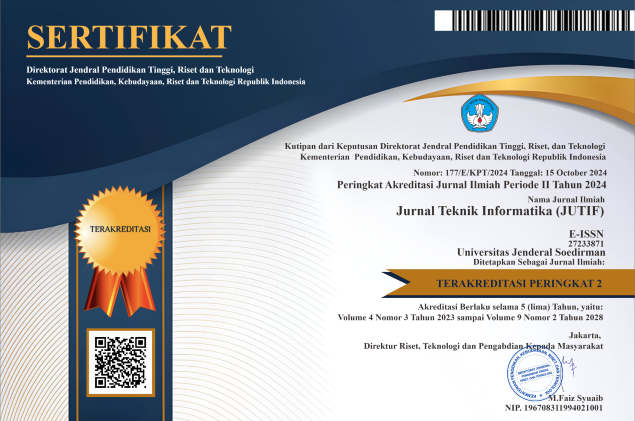Mosquito Species Classification Using Wingbeat Acoustic Signals Based on Bidirectional Long Short-Term Memory
DOI:
https://doi.org/10.52436/1.jutif.2025.6.4.4922Keywords:
Acoustic Classification, BiLSTM, Ensemble Learning, LPC, WingbeatAbstract
The increasing prevalence of mosquito-borne diseases such as Dengue, chikungunya, and malaria underscores the urgent need for effective mosquito vector monitoring. This study proposes a non-invasive classification system of mosquito species based on wingbeat acoustic signals using a deep learning approach with Bidirectional Long Short-Term Memory (BiLSTM). The audio dataset was collected from the Wingbeats repository, consisting of six major mosquito species. Preprocessing was performed using Discrete Wavelet Transform (DWT) to reduce noise. Feature extraction combined Linear Predictive Coding (LPC) and Mel-Spectrogram to represent spectral and temporal signal characteristics. Each binary model was trained in a one-vs-rest scheme to recognize a target species against others, and a BaggingClassifier was used to fuse predictions from six BiLSTM models. Evaluation showed that the proposed system achieved a final accuracy of 96.85% and F1-score of 95.03%, with confusion matrices showing near-diagonal performance. The results indicate that the hybrid LPC-Mel features and ensemble BiLSTM architecture are effective for mosquito species classification using acoustic signals.
Downloads
References
VOA Indonesia, “Mewaspadai Peningkatan Kasus Demam Berdarah di Musim Kemarau,” Jun. 14, 2023. [Online]. Available: https://www.voaindonesia.com/a/mewaspadai-peningkatan-kasus-demam-berdarah-di-musim-kemarau/7136639.html (accessed Sep. 25, 2024).
Alodokter, “Chikungunya,” 2025. [Online]. Available: https://www.alodokter.com/chikungunya (accessed Sep. 25, 2024).
M. Pirani, C. Lorenz, T. S. de Azevedo, G. L. Barbosa, M. Blangiardo, and F. Chiaravalloti-Neto, “Effects of the El Niño-Southern Oscillation and seasonal weather conditions on Aedes aegypti infestation in the State of São Paulo (Brazil): A Bayesian spatio-temporal study,” PLoS Negl Trop Dis, vol. 18, no. 9, p. e0012397, Sep. 2024, doi: 10.1371/journal.pntd.0012397.
CNN Indonesia, “April 2025, Kemenkes Justru Catat Kematian Akibat DBD Hampir 200 Jiwa,” Apr. 24, 2025. [Online]. Available: https://www.cnnindonesia.com/gaya-hidup/20250424083315-255-1222001/april-2025-kemenkes-justru-catat-kematian-akibat-dbd-hampir-200-jiwa (accessed May. 1, 2025).
P. Rajan, D. Goswami, Vanlalhmuaka, S. Datta, B. Rabha, and D. V. Kamboj, “Acoustic behaviour and flight tone frequency changes in adult Aedes albopictus and Culex quinquefasciatus mosquitoes,” Sci Rep, vol. 15, no. 1, Dec. 2025, doi: 10.1038/s41598-025-89608-7.
E. Toledo et al., “LSTM-based mosquito genus classification using their wingbeat sound,” in Frontiers in Artificial Intelligence and Applications, IOS Press BV, Sep. 2021, pp. 293–302. doi: 10.3233/FAIA210028.
R. Charoenpanyakul et al., “Enhancing mosquito classification through self-supervised learning,” Sci Rep, vol. 14, no. 1, Dec. 2024, doi: 10.1038/s41598-024-78260-2.
J. H. Rony, N. Karim, M. A. Rouf, S. B. Noor, and F. H. Siddiqui, “Mosquito Species Classification through Wingbeat Analysis: A Hybrid Machine Learning Approach,” in 2023 International Conference on Next-Generation Computing, IoT and Machine Learning, NCIM 2023, Institute of Electrical and Electronics Engineers Inc., 2023. doi: 10.1109/NCIM59001.2023.10212515.
Mariyanto and H. F. Pardede, “Identification of Aedes Mosquitoes with Audio Data Using Gammatone Filter,” in Proceeding - 2024 International Conference on Information Technology Research and Innovation, ICITRI 2024, Institute of Electrical and Electronics Engineers Inc., 2024, pp. 164–169. doi: 10.1109/ICITRI62858.2024.10699195.
X. Wei, M. Z. Hossain, and K. A. Ahmed, “A ResNet attention model for classifying mosquitoes from wing-beating sounds,” Sci Rep, vol. 12, no. 1, Dec. 2022, doi: 10.1038/s41598-022-14372-x.
B. J. Szekeres, M. Natabara Gyongyossy, and J. Botzheim, “A ResNet-9 Model for Insect Wingbeat Sound Classification,” in 2023 IEEE Symposium Series on Computational Intelligence, SSCI 2023, Institute of Electrical and Electronics Engineers Inc., 2023, pp. 587–592. doi: 10.1109/SSCI52147.2023.10371871.
D. Vasconcelos, N. J. Nunes, A. Förster, and J. P. Gomes, “Optimal 2D audio features estimation for a lightweight application in mosquitoes species: Ecoacoustics detection and classification purposes,” Comput Biol Med, vol. 168, Jan. 2024, doi: 10.1016/j.compbiomed.2023.107787.
A. Al Maruf, M. M. Haque, R. A. Rumy, J. J. Puspo, and Z. Aung, “TransembleNet: Enhancing vector mosquito species classification through transfer learning-based ensemble model,” PLoS One, vol. 20, no. 5 May, May 2025, doi: 10.1371/journal.pone.0322171.
G. Ngo, R. Beard, and R. Chandra, “Evolutionary bagging for ensemble learning,” Neurocomputing, vol. 510, pp. 1–14, Oct. 2022, doi: 10.1016/j.neucom.2022.08.055.
I. Kiskin, D. Zilli, Y. Li, M. Sinka, K. Willis, and S. Roberts, “Bioacoustic detection with wavelet-conditioned convolutional neural networks,” Neural Comput Appl, vol. 32, no. 4, pp. 915–927, Feb. 2020, doi: 10.1007/s00521-018-3626-7.
J. Xu, M. Davis, and R. de Frein, “New robust LPC-based method for time-resolved morphology of high-noise multiple frequency signals,” in Proc. IEEE, 2020, doi: 10.1109/ISSC49989.2020.9180212.
S. M. Williams, N. Aldabashi, P. Cross, and C. Palego, “Challenges in Developing a Real-Time Bee-Counting Radar,” Sensors, vol. 23, no. 11, Jun. 2023, doi: 10.3390/s23115250.
H. Li, J. Li, H. Liu, T. Liu, Q. Chen, and X. You, “MelTrans: Mel-Spectrogram Relationship-Learning for Speech Emotion Recognition via Transformers,” Sensors, vol. 24, no. 17, Sep. 2024, doi: 10.3390/s24175506.
K. Kushwaha, “Exploring Mel Spectrograms: A Powerful Feature Extraction Tool for Audio Signals,” Medium, Aug. 3, 2023. [Online]. Available: https://medium.com/@kunalkushwahatg/exploring-mel-spectrograms-a-powerful-feature-extraction-tool-for-audio-signals-3b68ff6fcf96 (accessed: Feb. 3, 2025).
P. Raghuwanshi and R. Kaushik, “Insect Classification Using Mel-CSTFT: A Fusion of Mel Spectrogram and Chroma STFT Features,” in Proceedings - 1st International Conference on Electronics, Communication and Signal Processing, ICECSP 2024, Institute of Electrical and Electronics Engineers Inc., 2024. doi: 10.1109/ICECSP61809.2024.10698728.
Z. Neili and K. Sundaraj, “Addressing Varying Lengths in PCG Signal Classification with BiLSTM Model and MFCC Features,” in Proceedings - 8th IEEE International Conference on Image and Signal Processing and their Applications, ISPA 2024, Institute of Electrical and Electronics Engineers Inc., 2024. doi: 10.1109/ISPA59904.2024.10536851.
P. Zhou, X. Xie, Z. Lin, and S. Yan, “Towards Understanding Convergence and Generalization of AdamW,” IEEE Trans Pattern Anal Mach Intell, vol. 46, no. 9, pp. 6486–6493, 2024, doi: 10.1109/TPAMI.2024.3382294.
Q. Wang, Y. Ma, K. Zhao, and Y. Tian, “A Comprehensive Survey of Loss Functions in Machine Learning,” Annals of Data Science, vol. 9, no. 2, pp. 187–212, Apr. 2022, doi: 10.1007/s40745-020-00253-5.
J. Kozak, B. Probierz, K. Kania, and P. Juszczuk, “Preference-Driven Classification Measure,” Entropy, vol. 24, no. 4, Apr. 2022, doi: 10.3390/e24040531.
R. Rachmawan, “Mengurai metrics: Apa itu presisi, recall, dan bagaimana menginterpretasikannya?,” Medium, Apr. 18, 2022. [Online]. Available: https://medium.com/himit-pens/mengurai-metrics-apa-itu-presisi-recall-dan-bagaimana-menginterpretasikannya-a15e7f90411e (accessed: April. 10, 2025).
Additional Files
Published
How to Cite
Issue
Section
License
Copyright (c) 2025 Bella Melati Wiranur Dwifani, Fatan Kasyidi, Ridwan Ilyas

This work is licensed under a Creative Commons Attribution 4.0 International License.



























